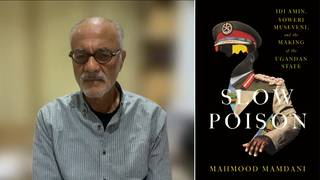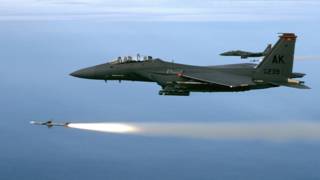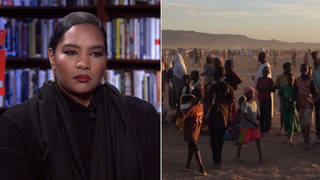
We speak with reporter Matthieu Aikins about how his investigation for The New York Times found an August 29 U.S. drone strike, which the Pentagon claimed targeted a facilitator with the militant group ISIS-K, actually killed 10 Afghan civilians, including seven children and Zemari Ahmadi, an Afghan engineer who had worked since 2006 for an American aid group. A review of video evidence by the Times shows Zemari loading canisters of water at the charity’s office, after the Pentagon claimed surveillance video showed Zemari loading what they thought were explosives into a car at an unknown compound earlier in the day. “We put together evidence that showed that what the military interpreted as a series of suspicious moves from the sky was, according to his co-workers and colleagues and video evidence, just an ordinary day for this aid worker,” says Aikins.
Transcript
AMY GOODMAN: This is Democracy Now!, democracynow.org, The War and Peace Report. I’m Amy Goodman, with Juan González.
We turn now to Afghanistan. It’s been one month since the Taliban seized control of Kabul after Afghan President Ashraf Ghani fled the country. On Tuesday, U.S. Secretary of State Tony Blinken defended the U.S. withdrawal from Afghanistan during a second day of questioning on Capitol Hill. Blinken was grilled about a U.S. drone strike in Kabul on August 29th. It’s the last drone strike before the withdrawal. The Pentagon claimed the strike targeted a facilitator with the militant group ISIS-K who was preparing to attack the Kabul airport. But local residents said the strike killed 10 Afghan civilians, including seven children and Zemari Ahmadi — not an ISIS-K operative, but an Afghan engineer who had worked since 2006 for the California-based charity group Nutrition and Education International. The Pentagon claims surveillance video showed Zemari loading what they thought were explosives into a car at an unknown compound earlier in the day. But video evidence obtained by The New York Times found Zemari was actually loading canisters of water at the charity’s office to deliver to those in need. The Pentagon has described the drone attack as a “righteous” strike. But on Tuesday, Secretary of State Blinken acknowledged the U.S. is not certain who was targeted, when questioned by Republican Senator Rand Paul.
SEN. RAND PAUL: The guy the Biden administration droned, was he an aid worker or an ISIS-K operative?
SECRETARY OF STATE ANTONY BLINKEN: The administration is, of course, reviewing that — that strike, and I’m sure that a, you know, full assessment will be — will be forthcoming.
SEN. RAND PAUL: So you don’t know if it was an aid worker or an ISIS-K operative?
SECRETARY OF STATE ANTONY BLINKEN: I can’t speak to that. And I can’t speak to that in this setting, in any event.
SEN. RAND PAUL: So, you don’t know or won’t tell us?
SECRETARY OF STATE ANTONY BLINKEN: I don’t — I don’t know, because we’re reviewing it.
SEN. RAND PAUL: Well, see, you’d think that you’d kind of know, before you off somebody with a Predator drone, whether he’s an aid worker or he’s an ISIS-K. See, the thing is, is this isn’t just you. It’s been going on for administration after administration.
AMY GOODMAN: We go now to Kabul, Afghanistan, where we’re joined by Matthieu Aikins of The New York Times. He wrote the recent piece headlined “In U.S. Drone Strike, Evidence Suggests No ISIS Bomb.”
Matthieu, talk about going to the site, to the family’s home, where the car was, and describe what you learned happened that day, August 29th.
MATTHIEU AIKINS: Well, August 29th, there was the strike in the evening. And we went the next morning, myself and a photographer for the Times, Jim Huylebroek, and we arrived at the scene. It was inside a courtyard of a house, where a car had been hit. And there was a small crater, still flesh and blood spattered around the interior of the courtyard. And we spoke to the family who lived there, and they were extremely distraught, because they had just lost 10 members of the family, including seven children. So, it was immediately apparent that there had been civilian casualties in the strike. And then, you know, when we followed up with our investigation over the past two weeks, we put together evidence that showed that this — what the military interpreted as a series of suspicious moves from the sky was, according to his co-workers and colleagues and video evidence, just an ordinary day for this aid worker.
JUAN GONZÁLEZ: And, Matthieu, the continued stonewalling, effectively, of the government in terms of what they have found out since is really remarkable. I’m just wondering — basic stuff like how many people died. And there’s a big difference between 10 and the official count that the U.S. is still saying of three civilians. They haven’t quite explained why they claimed Mr. Ahmadi was driving into an unknown compound at one point, which actually was the aid agency’s headquarters in Kabul. And also, they’re not even making clear whether they’ve checked if he was an employee of this U.S.-based aid group. What do you make of this continued almost refusal to explain the results of what they’ve investigated so far?
MATTHIEU AIKINS: Well, certainly, they have a lot to answer for, a lot to explain. But they are conducting an investigation, and typically when the military does this sort of investigation, you do have to wait for the results. They’re going to be classified, but they’ll probably brief them to lawmakers and then eventually release a redacted version of the investigation. So, at this point, I don’t think we’re going to hear anything, at least not officially, until that’s completed.
AMY GOODMAN: On September 1st, the chair of the Joint Chiefs of Staff, General Mark Milley, described the drone attack as a “righteous” strike.
GEN. MARK MILLEY: We know that there were secondary explosions. Because there were secondary explosions, there is a reasonable conclusion to be made that there was explosives in that vehicle. The third thing is, we know from a variety of other means that at least one of those people that were killed was an ISIS facilitator. So, were there others killed? Yes, there are others killed. Who they are, we don’t know. We’ll try to sort through all that. But we believe that the procedures, at this point — I don’t want to influence the outcome of an investigation — but, at this point, we think that the procedures were correctly followed and it was a righteous strike.
AMY GOODMAN: So, that’s General Mark Milley. Evidence examined by The New York Times at the scene of the drone strike suggests there was not a second explosion.
NARRATOR: We gathered photos and videos of the scene taken by journalists and visited the courtyard multiple times. We shared the evidence with three weapons experts, who said the damage was consistent with the impact of a Hellfire missile. They pointed to the small crater beneath Ahmadi’s car, and the damage from the metal fragments of a warhead. This plastic melted as a result of a car fire triggered by the missile strike.
All three experts also pointed out what was missing: any evidence of the large secondary explosions described by the Pentagon — no collapsed or blown-out walls, including next to the trunk with the alleged explosives; no sign that a second car parked in the courtyard was overturned by a large blast; no destroyed vegetation. All of this matches what eyewitnesses told us, that a single missile exploded and triggered a large fire.
AMY GOODMAN: So, that’s The New York Times video report based on Matthieu Aikins’ investigation of the U.S. drone strike. So, if you could elaborate on that, Matthieu, and also talk about why the children, why there were seven children in Zemari’s car?
MATTHIEU AIKINS: Sure. Well, the investigation was definitely a team effort. And we had experts look at the photos and videos that we were able to collect from the scene. And that was really the military’s justification, from what we’ve learned at least thus far, for taking the strike, you know, that this was an imminent threat to the airport, because they took the shot inside a crowded residential neighborhood, where there was a very high likelihood of civilian casualties. You know, that’s a kind of assumption that I think would have been fair in that circumstance. So, really, the way they would have justified this was that this was a car bomb or some kind of imminent threat. And I think it’s pretty conclusive that there was not a larger explosive in this car.
Now, what happened was, is that Zemari’s family, you know, the kids — he lived with his three brothers, so there was a lot of kids in this house. And when he came home every day from work, as I was told by his brother, you know, he’d pull up, and the kids would run out, and they’d be excited to see him. And they’d get in the car, and, you know, usually one of them would sit behind the wheel, maybe on his lap, and they would back the car in the courtyard. So, that’s what they said happened that day, so those kids were in the car when it was struck by a Hellfire missile. And that is the reason why seven of them were killed.
JUAN GONZÁLEZ: And, Matthieu, what does this — from your reporting in Afghanistan, what does this tell us about the limitations of these drone strikes, the inherent problems that exist when you rely, essentially, on aerial surveillance to determine who you strike, or not, versus on-the-ground, real human intelligence?
MATTHIEU AIKINS: Yeah. So, this is not an isolated incident. You know, we’ve had civilian casualties from drone strikes many times over the years. But the fact of the matter was, this happened in Kabul. You know, I was able to go to the scene, and we were able to do the story in two weeks. Normally these happen in remote, dangerous areas, difficult to access. So, often all we have is the military’s official version of the events — in this case, that this guy was an ISIS facilitator and that there was explosives in the car.
So, the danger with these strikes, which — again, this may have been the last drone strike of the 20-year American war, but the war on terror continues, and there’s going to be more drone strikes, you know, as promised by the administration, in an over-the-horizon role in places like Afghanistan. The danger is that we’re going to have more of these incidents, there’s going to be more children killed, but that we’re not going to really even know about it, because, again, we’re not going to have access to what’s happening on the ground.
AMY GOODMAN: And, of course, these drone strikes lessen the chance of U.S. soldiers being killed, as they fly over from another country, as you said, the over-the-horizon capability they’re talking about. But I wanted to go to one last video that you obtained, security camera footage from the office of the U.S.-based aid group Nutrition and Education International, where Zemari Ahmadi had worked earlier in the day.
NARRATOR: At 2:35 p.m., Ahmadi pulls out a hose. And then he and a co-worker fill empty containers with water. Earlier that morning, we saw Ahmadi bring these same empty plastic containers to the office. There was a water shortage in his neighborhood, his family said, so he regularly brought water home from the office.
AMY GOODMAN: So, we’re looking at this closed-circuit footage of him gathering this water to bring home. The U.S. apparently was monitoring him for hours that day, Matthieu.
MATTHIEU AIKINS: Yeah, they said that they were surveilling him with an MQ-9 Reaper drone. But, again, you know, what they see from the sky and what’s happening on the ground are not necessarily the same thing. And in this case, you know, this was a man who had loaded water in the car to bring home to his family.
AMY GOODMAN: Well, Matthieu, we want to thank you so much for being with us. Matthieu Aikins, Kabul-based contributing writer to The New York Times and The New York Times Magazine, his investigation into the drone strike headlined “In U.S. Drone Strike, Evidence Suggests No ISIS Bomb.”
Next up, we go to a clinical social worker helping undocumented 9/11 responders and cleanup workers 20 years later, even to this day. Stay with us.













Media Options